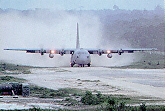C-130 Hercules

Mission
The C-130 Hercules primarily performs the intratheater portion of the airlift mission. The aircraft is capable of operating from rough, dirt strips and is the prime transport for paradropping troops and equipment into hostile areas.
Background
Four decades have elapsed since the Air Force issued its original design specification, yet the remarkable C-130 remains in production. The initial production model was the C-130A, with four Allison T56-A-11 or -9 turboprops. A total of 219 were ordered and deliveries began in December 1956. Two DC-130A's (originally GC-130A's) were built as drone launchers/directors, carrying up to four drones on underwing pylons. All special equipment was removable, permitting the aircraft to be used as freighters, assault transports, or ambulances. The C-130B introduced Allison T56-A-7 turboprops and the first of 134 entered Air Force service in April 1959. C-130B's are used in aerial fire fighting missions by Air National Guard and Air Force Reserve units. Six C-130B's were modified in 1961 for snatch recovery of classified U.S. Air Force satellites by the 6593rd Test Squadron at Hickam Air Force Base, Hawaii.
Features
In its personnel carrier role, the C-130 can accommodate 92 combat troops or 64 fully equipped paratroops on side-facing seats. For medical evacuations, it carries 74 litter patients and two medical attendants. Paratroopers exit the aircraft through two doors on either side of the aircraft behind the landing-gear fairings. Another exit is off the rear ramp for airdrops.
The C-130 Hercules joins on mercy flights throughout the world, bringing in food, clothing, shelter, doctors, nurses and medical supplies and moving victims to safety.
C-130 Hercules have served other nations, airlifting heavy equipment into remote areas to build airports and roads, search for oil ,and transport local goods.
As a partial response to the overwhelming role played by the tactical airlift fleet in Operation Just Cause and in the Persian Gulf War, Congress has approved the procurement of more C-130H's to replace the aging E models.
General Characteristics
Primary
Function: Intratheater airlift.
Contractor: Lockheed
Aeronautical Systems Company.
Power
Plant: Four Allison T56-A-15 turboprops; 4,300 horsepower,
each engine.
Length: 97
feet, 9 inches (29.3 meters).
Height: 38
feet, 3 inches (11.4 meters).
Wingspan: 132
feet, 7 inches (39.7 meters).
Speed: 374
mph (Mach 0.57) at 20,000 feet (6,060 meters).
Ceiling: 33,000
feet (10,000 meters) with 100,000 pounds (45,000 kilograms) payload.
Maximum
Takeoff Weight: 155,000 pounds (69,750 kilograms).
Range: 2,356
miles (2,049 nautical miles) with maximum payload; 2,500 miles (2,174 nautical
miles) with 25,000 pounds (11,250 kilograms) cargo; 5,200 miles (4,522
nautical miles) with no cargo.
Unit
Cost: $22.9 million (1992 dollars).
Crew: Five
(two pilots, a navigator, flight engineer and loadmaster); up to 92 troops
or 64 paratroops or 74 litter patients or five standard freight pallets.
Date
Deployed: April 1955.
Inventory: Active
force, 98; ANG, 20 Bs, 60 E's and 93 H's; Reserve, 606.
